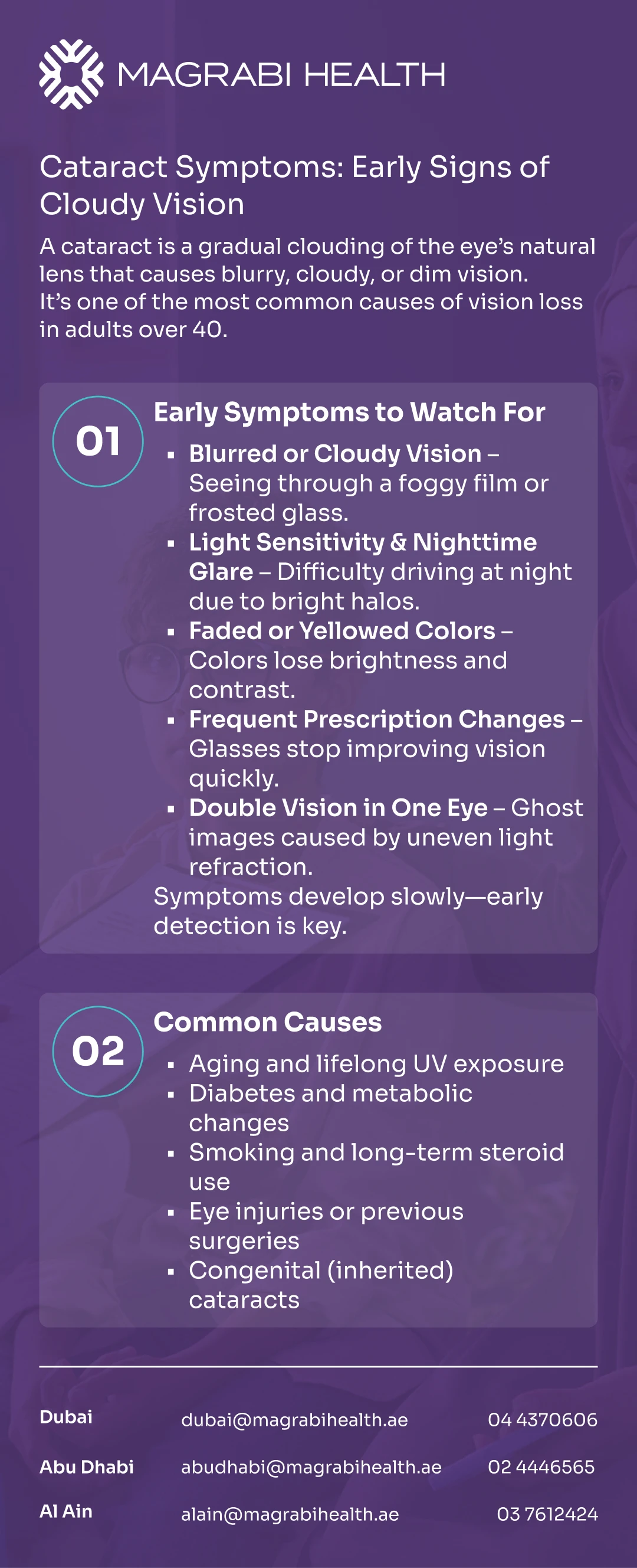Last updated: 1/11/2025
Cataracts often begin quietly. The earliest cataract symptoms can be subtle slight haze, a touch of glare, or colors that no longer look quite right. In sun-intense cities like Dubai and Abu Dhabi, recognizing the early symptoms of cataracts helps you seek timely care before everyday tasks such as night driving or reading become stressful.
This guide explains the beginning stages of cataracts, how cataracts affect vision, and when to see a specialist—gently leading you toward confident, informed decisions.
Not sure if your cloudy vision could be an early sign of cataract? Book your personalized consultation today with Magrabi Health’s eye specialists.
Even mild lens clouding can change the way light enters your eye. These are the cataract symptoms people commonly notice first.

Many patients describe a foggy film or “frosted glass” effect. This haziness comes from protein changes in the lens that scatter light, producing classic cataract vision changes even when your glasses are up-to-date.
Headlights, street lamps, and reflective surfaces can create halos and starbursts. With advancing cataract symptoms, night driving often feels unsafe due to increased glare and reduced contrast.
Colors may look dull, whites seem creamy, and fine contrast is harder to see. These signs of cataract reflect how the lens filters and scatters light.
If you’re changing glasses repeatedly yet clarity doesn’t last, that’s a red flag. Refractive shifts are common in the beginning stages of cataracts.
Monocular double vision—ghost images in a single eye—can appear as light bends irregularly through the clouded lens.
If these cataract symptoms sound familiar, schedule a professional eye exam to confirm the cause and plan next steps.
Cataracts are largely age-related changes in the lens, but several factors can accelerate them. Understanding common cloudy vision causes—from cumulative UV exposure and diabetes to smoking and long-term steroids—helps you anticipate the effects of cataracts on everyday tasks like night driving and reading.
Aging & UV Exposure: Lifelong sunlight (especially in the UAE) promotes oxidative changes in the lens—key cloudy vision causes.
Diabetes & Metabolic Conditions: Elevated glucose alters lens proteins and draws fluid into the lens, hastening cataract vision changes.
Smoking & Long-Term Steroids: Lifestyle and medication factors increase the effects of cataracts over time.
Eye Injuries or Surgeries: Trauma or prior procedures can lead to secondary cataracts.
Congenital or Early-Onset: Rarely, children can develop cataracts due to genetics, infections, or metabolic disorders.
Regain clear vision and confidence through advanced cataract care —visit our Cataract Care page to learn more.
Diagnosis is quick, painless, and precise—aimed at confirming cataract symptoms, understanding how cataracts affect vision, and ruling out other causes of blurred vision symptoms.
Measures how clearly you see letters at distance and near, establishing a baseline for your cataract vision changes.
A microscope with a focused beam lets the specialist inspect your lens for the early signs of cataract, including where the clouding sits and how dense it is.
Drops gently widen your pupil so your doctor can evaluate the lens, retina, and optic nerve clarifying how cataracts affect vision versus other conditions.
Retinal imaging or pressure checks help ensure symptoms aren’t from macular disease or glaucoma.
Early confirmation turns uncertainty into a clear, personalized plan.
If you notice persistent haze, night glare, or frequent prescription changes, it’s time for a comprehensive eye check-up in the UAE.
Regular exams after 40 especially with strong sun exposure catch early cataract symptoms while treatment is simplest and recovery is fastest.
Treatment is tailored to your lifestyle, symptoms, and exam findings.
Brighter reading lights, anti-glare lenses, and UV-blocking sunglasses can ease cataract symptoms for a while. These measures don’t reverse cataracts but can keep you comfortable.
When cataract vision changes limit daily life, modern day-surgery removes the cloudy lens through a tiny incision and replaces it with a clear intraocular lens (IOL). The procedure is brief, uses local anesthesia, and recovery is typically rapid.
Premium IOLs (e.g., toric for astigmatism, multifocal for distance and near) and image-guided systems refine outcomes—reassuring patients seeking trusted care in Dubai and Abu Dhabi.
Discuss options with your specialist to match vision goals, lifestyle, and budget.
Cataracts can dim life’s details, yet recognizing cataract symptoms early makes all the difference. If glare, haze, or color dullness has crept into your day, a precise diagnosis and modern care can restore clarity—safely and predictably.
Book your personalized consultation today with Magrabi Health’s cataract specialists, and take the first step toward brighter, clearer vision.
American Academy of Ophthalmology (AAO). Cataract: Causes, Symptoms, and Treatment. Updated 2025.
National Eye Institute (NEI). Facts About Cataract. U.S. Department of Health & Human Services.
National Institute for Health and Care Excellence (NICE). Cataracts in Adults: Management (NG77). 2023.
World Health Organization (WHO). Universal Eye Health: Global Action Plan for the Prevention of Blindness 2020–2030.
This article is for educational purposes only and should not be considered medical advice. Cataract symptoms and treatment options can vary from one patient to another. Always consult a licensed ophthalmologist or qualified eye specialist for personalized diagnosis and management.
Consultant Ophthalmologist & Cataract and Glaucoma Specialist
Magrabi Health – Abu Dhabi Branch.